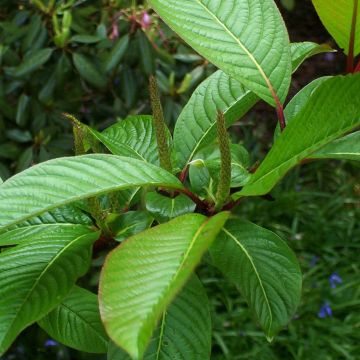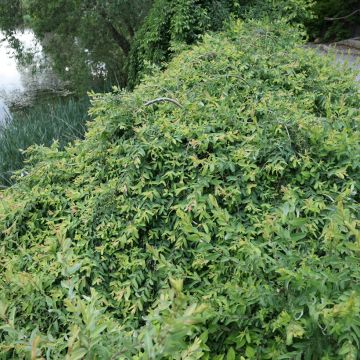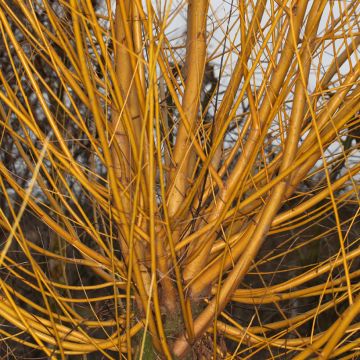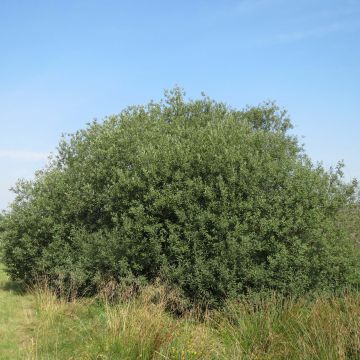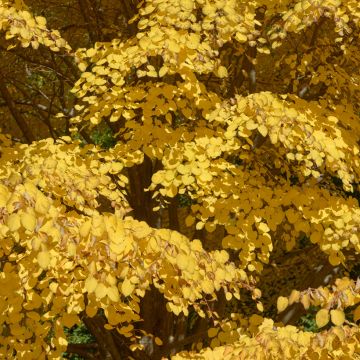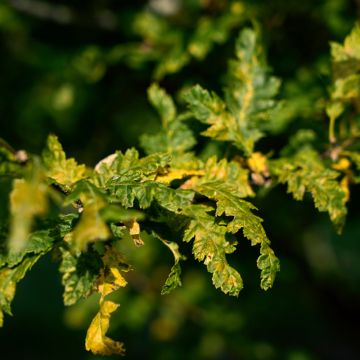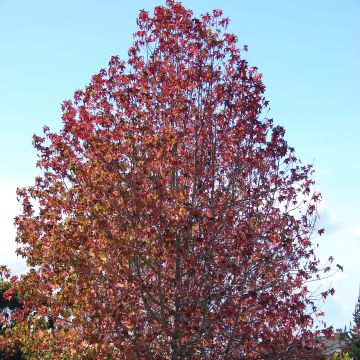

Salix sachalinensis Sekka - Sachalin Willow
Salix sachalinensis Sekka - Sachalin Willow
Salix sachalinensis Sekka
Sachalin Willow, Ussuri Willow, Japanese Fantail Willow
Very beautiful Willow. Very well packaged and arrived intact. Impeccable, as usual.
Raf, 11/05/2023
This item cannot be shipped to the selected country
Oversize package delivery charge from €6.90
Delivery to Corse prohibited
More information
Schedule delivery date,
and select date in basket
This plant carries a 24 months recovery warranty
More information
We guarantee the quality of our plants for a full growing cycle, and will replace at our expense any plant that fails to recover under normal climatic and planting conditions.
Oversize package: home delivery by special carrier from €6.90 per order..
Express home delivery from €8.90.
Delivery to Corse prohibited: UE law prohibits the import of this plant from mainland France to Corse as part of the fight against Xylella fastidiosa. Please accept our sincere apologies.
More information

Does this plant fit my garden?
Set up your Plantfit profile →
Description
Text to translate:
The Salix sachalinensis 'Sekka' is the least original variety of Sakhalin willow, of Japanese origin. This male clone forms a large bush or a small tree often as wide as it is high, the red-brown branches of which take on a beautiful purple-red hue while flattening over time, up until they split. Its early and abundant spring flowering is another asset of this willow, which produces a multitude of large, feathery, silver then yellow catkins, before the elegant, beautiful, shiny green foliage appears. Decorative all year round, this unusual willow has its place in an inquisitive person's or a collector's garden, or in a Japanese or contemporary style garden.
The Sakhalin Willow (syn. Salix udensis), from the Salicaceae family, is a botanical species native to northeast Asia and northern Japan. The particularly ornamental Japanese cultivar 'Sekka' is appreciated for its curiously organised flattened branches join and criss-cross, particularly in Japanese floral art and Ikebana designs. The 'Sekka' forms a large bush with a both erect and spreading, as well as twisting habit, which can be kept compact by regular pruning, every 3 years. At maturity, it will reach about 5 m (16 ft 5 in) in height by 4 m (13 ft 1 in) in width, but in some cases it may be wider than it is high. Its growth is moderately rapid. Its branches are slightly twisted with flattened ends, 5 cm (2 in) wide and not very thick. They are covered with a red-brown bark when young, becoming purple-red, traversed by green lines and which split over time. The deciduousconsists of long lanceolate leaves with finely dentate margins, 7 cm (2.8 in) long on average. They are a shiny green on top, rather blue-green and slightly villous underneath, and turn yellow in autumn. This willow only has male aments, produced in abundance at the beginning of spring, usually in March-April on the naked branches. Thicker than on the type species, they are ovoid, 3 cm (1.2 in) long, feathery and silky, light grey when budding, becoming pale yellow when the stamens ripen.
The very unusual Willow likes deep, cool soil as well as a very bright exposure, but tolerates the presence of limestone, or on the contrary acidic soil. It makes a sensation in isolation, dominating a tapetum of Japanese grass, Carex, euphorbias, alchemilla that will not eclipse its particular charm. It can also be surrounded by early flowering bulbs (snowdrops, crocuses, fritillaries, hyacinths). It can also be used in a free or pruned hedge to reinforce the Japanese side of a Zen garden. Finally, consider placing it so that it is visible from the house, in order to contemplate its extraordinary silhouette from the warmth of a window.
Report an error about the product description
Salix sachalinensis Sekka - Sachalin Willow in pictures


Plant habit
Flowering
Foliage
Botanical data
Salix
sachalinensis
Sekka
Salicaceae
Sachalin Willow, Ussuri Willow, Japanese Fantail Willow
Cultivar or hybrid
Other Willow - Salix
Planting and care
The Salix sachalinensis 'Sekka' is preferably planted in the autumn, from September to November, in any deep, cool, rich, properly drained soil. It is indifferent to the type of soil, provided that is is deep enough and does not dry out too quickly. Choose a very sunny exposure. Water and mulch the young plants. To limit development, periodically cut back (every 3 years) all the branches. Such pruning back short during the winter is often the best way to contain attacks from anthracnose (black spots, splitting), a cryptogamic disease that attacks young shoots during damp springs. Collect the fallen leaves in autumn and burn them if the tree presents black spots (anthracnose) or orange-yellow (rust) during its growth. Once all the leaves have fallen, treat with a Bordeaux mixture. Pruning at the end of winter limits risks. It can also be a victim of cankers at the site of pruning wounds, as well as aphids. Protect the pruning wounds with a healing mastic.
Planting period
Intended location
Care
-
, onOrder confirmed
Reply from on Promesse de fleurs
Striking foliage shrubs
Haven't found what you were looking for?
Hardiness is the lowest winter temperature a plant can endure without suffering serious damage or even dying. However, hardiness is affected by location (a sheltered area, such as a patio), protection (winter cover) and soil type (hardiness is improved by well-drained soil).

Photo Sharing Terms & Conditions
In order to encourage gardeners to interact and share their experiences, Promesse de fleurs offers various media enabling content to be uploaded onto its Site - in particular via the ‘Photo sharing’ module.
The User agrees to refrain from:
- Posting any content that is illegal, prejudicial, insulting, racist, inciteful to hatred, revisionist, contrary to public decency, that infringes on privacy or on the privacy rights of third parties, in particular the publicity rights of persons and goods, intellectual property rights, or the right to privacy.
- Submitting content on behalf of a third party;
- Impersonate the identity of a third party and/or publish any personal information about a third party;
In general, the User undertakes to refrain from any unethical behaviour.
All Content (in particular text, comments, files, images, photos, videos, creative works, etc.), which may be subject to property or intellectual property rights, image or other private rights, shall remain the property of the User, subject to the limited rights granted by the terms of the licence granted by Promesse de fleurs as stated below. Users are at liberty to publish or not to publish such Content on the Site, notably via the ‘Photo Sharing’ facility, and accept that this Content shall be made public and freely accessible, notably on the Internet.
Users further acknowledge, undertake to have ,and guarantee that they hold all necessary rights and permissions to publish such material on the Site, in particular with regard to the legislation in force pertaining to any privacy, property, intellectual property, image, or contractual rights, or rights of any other nature. By publishing such Content on the Site, Users acknowledge accepting full liability as publishers of the Content within the meaning of the law, and grant Promesse de fleurs, free of charge, an inclusive, worldwide licence for the said Content for the entire duration of its publication, including all reproduction, representation, up/downloading, displaying, performing, transmission, and storage rights.
Users also grant permission for their name to be linked to the Content and accept that this link may not always be made available.
By engaging in posting material, Users consent to their Content becoming automatically accessible on the Internet, in particular on other sites and/or blogs and/or web pages of the Promesse de fleurs site, including in particular social pages and the Promesse de fleurs catalogue.
Users may secure the removal of entrusted content free of charge by issuing a simple request via our contact form.
The flowering period indicated on our website applies to countries and regions located in USDA zone 8 (France, the United Kingdom, Ireland, the Netherlands, etc.)
It will vary according to where you live:
- In zones 9 to 10 (Italy, Spain, Greece, etc.), flowering will occur about 2 to 4 weeks earlier.
- In zones 6 to 7 (Germany, Poland, Slovenia, and lower mountainous regions), flowering will be delayed by 2 to 3 weeks.
- In zone 5 (Central Europe, Scandinavia), blooming will be delayed by 3 to 5 weeks.
In temperate climates, pruning of spring-flowering shrubs (forsythia, spireas, etc.) should be done just after flowering.
Pruning of summer-flowering shrubs (Indian Lilac, Perovskia, etc.) can be done in winter or spring.
In cold regions as well as with frost-sensitive plants, avoid pruning too early when severe frosts may still occur.
The planting period indicated on our website applies to countries and regions located in USDA zone 8 (France, United Kingdom, Ireland, Netherlands).
It will vary according to where you live:
- In Mediterranean zones (Marseille, Madrid, Milan, etc.), autumn and winter are the best planting periods.
- In continental zones (Strasbourg, Munich, Vienna, etc.), delay planting by 2 to 3 weeks in spring and bring it forward by 2 to 4 weeks in autumn.
- In mountainous regions (the Alps, Pyrenees, Carpathians, etc.), it is best to plant in late spring (May-June) or late summer (August-September).
The harvesting period indicated on our website applies to countries and regions in USDA zone 8 (France, England, Ireland, the Netherlands).
In colder areas (Scandinavia, Poland, Austria...) fruit and vegetable harvests are likely to be delayed by 3-4 weeks.
In warmer areas (Italy, Spain, Greece, etc.), harvesting will probably take place earlier, depending on weather conditions.
The sowing periods indicated on our website apply to countries and regions within USDA Zone 8 (France, UK, Ireland, Netherlands).
In colder areas (Scandinavia, Poland, Austria...), delay any outdoor sowing by 3-4 weeks, or sow under glass.
In warmer climes (Italy, Spain, Greece, etc.), bring outdoor sowing forward by a few weeks.


































